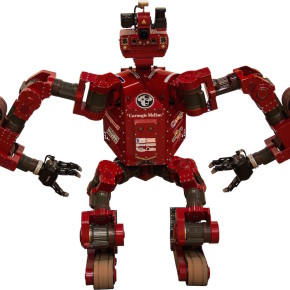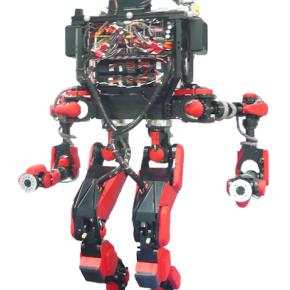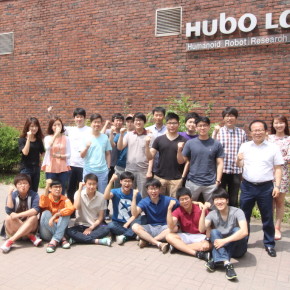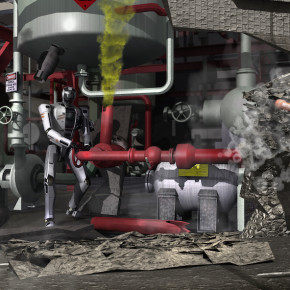
Robohub.org
DARPA’s Robotics Challenge: A pocket-sized guide to the finals
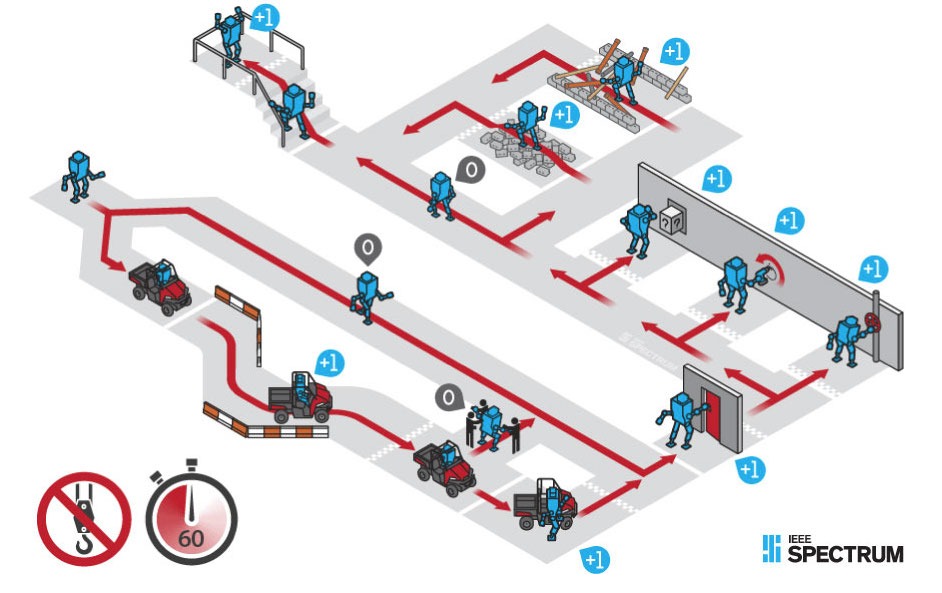
Illustration: James Provost & Erik Vrielink. Source: Automaton Blog.
DARPA’s latest Challenge reaches its climax on 6 June 2015, when 25 finalists compete for $3.5m of prize money in what’s possibly the most anticipated robotic contest ever. Since its inception in 2012, the event has lost its top competitor and the challenge is now even tougher. Here’s what you need to know to enjoy the event, in one handy guide.
The purpose
In the past three years, the US Defense Advanced Research Projects Agency (DARPA) has invested $96.6m in the DARPA Robotics Challenge (DRC) – a hugely ambitious program to develop robots capable of assisting humans in responding to natural and man-made disasters.
The DRC was inspired by the Fukushima disaster, and the US Department of Defense identifies disaster response as a priority area. In DARPA’s most recent briefing in mid-May, Programme Manager Gill Pratt broadly described the contest’s aims: “We really want to develop better tools, better techniques, ways of amplifying the effectiveness of our response to both natural and to manmade disasters.”
“If we could only better intervene from a distance in places where it’s too dangerous for human life, that would significantly add to our capabilities to mitigate the extent of disasters. That’s the problem that we’re trying to solve.”
In a disaster, one of the most problematic elements is a degradation of communication, and Pratt stressed that this is the most important aspect of the competition: “When you think about the DARPA Robotics Challenge, try to think beyond the physical robots, and focus on this very sporadic, very degraded communication between people and machines working together as partners.”
Why humanoids?
According to DARPA’s research with first-response experts, the key capability requirements point to a humanoid solution – the ability to go through doors, climb steep stairs, walk on rough terrain and to use the tools on hand – are all only really achievable by a humanoid robot.
So most of the robots have bipedal designs and are humanoid in appearance, with a couple of exceptions: Tartan Rescue‘s Chimp (CMU Highly Intelligent Mobile Platform), the long armed robot that finished third in the 2013 Trials, and NASA’s RoboSimian, which has four limbs for increased stability. There’s also Team NimbRo Rescue, which has a anthropomorphic upper body on a flexible hybrid mobile base.
Human-robot interfaces must be intuitive and simplicity of use is also a primary reason why so many of the teams use bipedal, human-like forms, including DARPA’s Atlas robot model.
The challenge
This will be the final challenge in a long process that started with a virtual event in 2013 and a physical trial run later that year. Through these two preliminary rounds of competition, DARPA and the DRC teams have redefined what is possible in robot power efficiency, supervised autonomy, physical adaptability and human-machine control interfaces.
The final challenge takes place in a simulated disaster zone. It will involve two attempts at eight tasks; seven of these will be derived from the challenges of the last round, and one surprise task will be introduced at the competition.
The robots will start in a vehicle, drive to a simulated disaster building, and then they’ll have to open doors, walk on rubble, and use tools. Finally they’ll have to climb a flight of stairs. The fastest team with the same amount of points for completing tasks will win.
The main issues teams will face are communications with their robot and battery life: “Even the best batteries are still roughly ten times less energy-dense than the kinds of fuels we all use to get around,” said Pratt.
What’s happened since the last phase?
The Programme has been extended and is now truly international. Half of the teams are from the US, but Japan, Korea and the EU have invested funds. Says Pratt: “It’s a really global challenge.”
The biggest change is, however, the withdrawal of Team SCHAFT, head-and-shoulders winners of the last phase of the challenge. SCHAFT, developed by a Japanese start-up, was acquired by Google in December. Their withdrawal last June underlines both Google’s claims that it has no interest in seeking funding from the military, and the US government’s need to not be seen as funding a major corporation.
The new emphasis on the communications aspect of the challenge means DARPA will be purposefully sabotaging the link between teams and their robots. During the Fukushima nuclear disaster, it was communication issues caused by heavy radiation shielding and power outages that proved most problematic for the robots tasked with entering the site. The DRC communication outages will last up to one minute to test how well these robots deal with similar situations.
The teams are provided with situation awareness to help them visualise what the robots are up to. A change in the rules forces teams to rely less upon the remote control of individual joints and motions and instead implement task-based interfaces that incorporate advanced perception, minimal human guidance, and complex autonomous behaviour.
DARPA has also decided that the robots will operate completely untethered. There won’t be cables to provide power and data, or keep the robots upright. In view of this, DARPA has swapped the ladders used in the last challenge for stairs, making it a little easier.
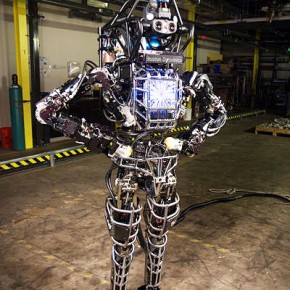
The Atlas robot, created by Bostron Dynamics and DARPA, was used by several teams in the DRC Trials. Source: DARPA
The ATLAS robot, used by the seven teams that are concentrating on software instead of hardware, has had an upgrade.The platform is manufactured by Boston Dynamics – another company recently acquired by Google.
Among the improvements to ATLAS is increased energy efficiency, with some teams now able to achieve several hours of functionality without the need for a recharge.
“We’ve provided these new robots with a very large, high-performance computer now, at least for the Atlas machines,” says Pratt. “But primarily what the robot is doing is perception, and I think that’s actually the hardest part of the job that it has. So it’s using the LiDAR sensors and the visual sensors that it has and it’s trying to decide what it is that it sees.”
DARPA is being fairly secretive about the specifics of the tasks the robots must perform: “We’ve been very purposefully not giving blueprints out to any of the teams to say this is exactly what the door handle will be like or what the valve will be like,” says Pratt. “I want to push the teams far away from trying to have scripted responses.”
The teams
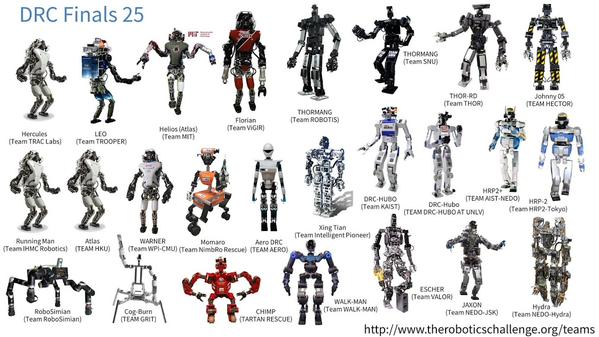
There will be 25 teams competing in total, half of them from the United States. Japan, Korea and Germany are well represented with a total of 10 teams between them.
Out of the 25, a total of 14 new teams from seven different countries have been added, qualifying to participate in the DRC Finals. And 11 teams previously qualified during the DRC Trials.
Seven teams are using Atlas and the other teams have developed their own robots, which come in a variety of sizes and shapes.
Speaking about the differing capabilities of the teams, Pratt said: “We don’t know exactly what all the teams are bringing to bear, but I would expect tremendous diversity in the amount of autonomy that you’re going to see there. In addition, there’s also a variety of different user interfaces. The most primitive one just leaves it to the human being to use their brain to do the imagination of what is taking place on the other side. The best of them is actually gathering all of the data since the beginning of the run and putting together a statistical view of what the most likely scenario is at the other side.”
Teams tipped for top spots include: KAIST, from South Korea and US challenger, Chimp.
What you can expect:
The robots will compete simultaneously across four courses during hour-long runs throughout the two days.
At the DRC Trials held last December, the robots often moved excruciatingly slowly and depended upon the careful control of remote human operators. At the June final, the robots will be “at least four times faster than in the trials, and perhaps even faster,” says Pratt.
However, some would disagree, in The NY Times, John Markoff writes:
“Nobody needs to worry about a Terminator creating havoc anytime soon. Given a year and a half to improve their machines, the roboticists who shared details about their work in interviews before the contest in June appear to have made limited progress.”
However, in the December trials, organisers thought it unlikely that the winning team could score more than 15 points, but four teams exceeded that number and SCHAFT won a total of 27. So expect the unexpected!
In the trials, driving appeared to be a particular challenge, with only a few contenders even attempting it. In the DRC Finals, driving will be the first task that teams will have to tackle. “With the driving challenge coming first before anything else, we will see immediately who is serious about the competition,” says Andra Keay from Silicon Valley Robotics. “It’s a big fence first up.”
Adequate power will also present a problem. DARPA are not allowing any recharging of the robots during the event. In fact, Pratt warned reporters that the challenges in June will be even harder and told them that the “degradation of communications is a fundamental part.”
The planned interruptions in communications will mean that, “a substantial fraction of the teams will have difficulties here.” Although, whenever the robots do have a network connection, they’ll have significantly more computing resources than were available in the last round.
The teams have had to move a lot of the low-level mobility and manipulation skills from the human operators to the machines; the robots will need enough autonomy and intelligence to do tasks in a fraction of a minute. “You should expect to see a lot of robots falling down, and a lot failures of different sorts,” said Pratt.
This is largely due to the planned communications failures and the lack of hoists or safety ropes. If a team becomes stuck and the robot can’t get up, they can elect to take a 10-minute penalty during which a simulation is made of what it would be like to send in a second robot in to continue the mission after the first one has got stuck. “The simulation of that will be done by the team retrieving the first robot, bringing it back to the starting line, and, if it’s still in working condition, starting it over with a 10-minute penalty,” said Pratt.
It seems the DRC finalists are currently still at task level rather than mission level.
“I want to be very realistic about what stage we’re in right now,” said Pratt. “These are prototypes that are meant to advance the technology and it might be 10 years from now until they’re out in the field. There’s a huge difference between science fact and science fiction. Robots in science fact are more modest because the technology isn’t anywhere near what science fiction would have us believe – but they’re also more exciting because they point the way to what may be possible in the future.”
Want to go, or just watch?
The event is free and open to the public, who will watch from the Fairplex grandstands in Pomona, California on 5 and 6 June; several thousand people are expected to attend. To complement the competition, an on-site robotics exhibition and technology demonstrations from around 70 different robotics and disaster response groups is planned. All kinds of robotics hardware and software companies will be exhibiting. To attend the event, you only need to register: http://www.theroboticschallenge.org/media.
The whole Finals event will be webcast in realtime HD on YouTube. The best time to watch will be towards the end of each competition day, as that’s when the finest of the machines will be directly competing with each other, each on their own course.
What happens afterwards
The closing ceremony on 6 June will be be followed by a workshop on 7 June. The three winning teams will present the strategies and techniques that they used to gain the top spots. This won’t be open to the public, but it will be webcast.
There will also be talks about the international efforts in the field, other competitions that are coming up in the future, the different investments that are being made in various countries. Experts will also discuss the future of the industry.
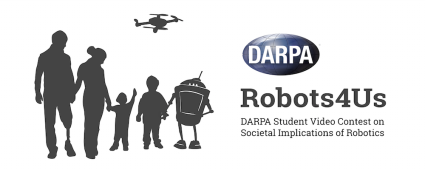
Part of the day will be given over to “Robots 4us” – a DARPA competition for high school students who were given the opportunity to produce a winning video on the role of robots in society in the years ahead.
DARPA sees the DRC as an opportunity to lay the technological foundations for more autonomous and capable robots in the commercial market. In fact, the success of the competition lies in part in the commercial investments in robotics that it inspires. To this end, DARPA and some of the teams plan to publish their experiences academically.
And Atlas? What of him? The simple answer is that the DRC organisers have not yet reached a decision about Atlas’ future.
Could we see some of the resulting technology put to military use? “The key answer is that the technology is by its nature generic,” said Pratt. “It could be used in future systems for defense, or it could be used in a number of fields, like healthcare.”
Why it’s important
In short, the stellar progress we’ve seen in driverless cars in the last decade owes everything to DARPA’s 2004 Autonomous Vehicle Grand Challenge.
The sale of the DRC Trials favourite SCHAFT and Atlas software manufacturers Boston Dynamics to Google would suggest history repeating itself.
The DRC has also helped in the development of tools; the organisers funded the development of the Open Source Robotics Foundation (OSRF) simulator, which was first used in the virtual challenge.
It can also take some of the credit for the amount of investment the robotics industry has seen lately. Says Pratt: “DARPA’s job is to show what’s possible. We do those early investments… and the best case is that the private sector picks that up.”
If you liked this article, you may also be interested in:
- Beginner’s guide to the humanoid robot challenge (DRC)
- DARPA’s Virtual Robotics Challenge a practical step forward on the long road toward disaster-response capable humanoids
- DARPA’s legacy: Open source simulation for robotics development and testing
- DARPA’s Gill Pratt on Google’s robotics investments
- DARPA’s HAPTIX project hopes to provide prosthetic hands with sense of touch
See all the latest robotics news on Robohub, or sign up for our weekly newsletter.
tags: ATLAS, c-Events, cx-Military-Defense, DARPA, DRC, OSRF


